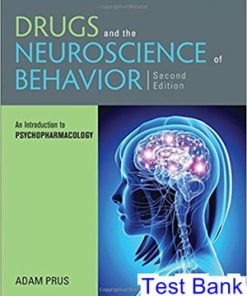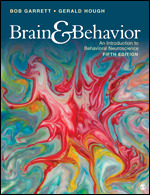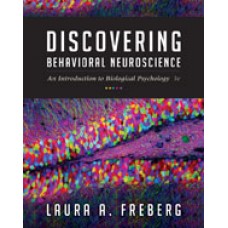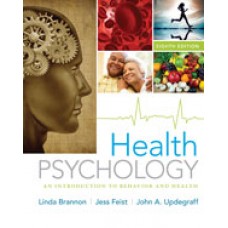Test Bank for An Introduction to Drugs and the Neuroscience of Behavior, 1st Edition : Prus
$35.00 Original price was: $35.00.$26.50Current price is: $26.50.
Test Bank for An Introduction to Drugs and the Neuroscience of Behavior, 1st Edition : Prus
This is completed downloadable of Test Bank for An Introduction to Drugs and the Neuroscience of Behavior, 1st Edition : Prus
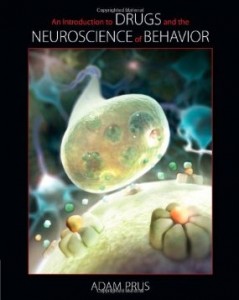
Product Details:
ISBN 10: 049590726X
ISBN 13: 9780495907268
Author: Prus, Adam
This up-to-date text provides an introductory overview of the nervous system actions and behavioral effects of the major classes of psychoactive drugs, using pedagogy unique among pharmacology texts to make the topic approachable. Available with InfoTrac Student Collections http://gocengage.com/infotrac.
Table of Content:
- Box 1.1 Instruments Used for Studying Subjective Effects in Humans
- Study Designs and the Assessment of Psychoactive Drugs
- Experiments
- Correlational Studies
- Validity and the Interpretation of Study Findings
- Ethical Considerations in Research
- A Lack of Feasible Alternatives to Animals
- High Predictive Value for Drug Effects in Humans
- The Regulation of Animal Research
- Researchers Consider Many Ethical Issues When Conducting Human Research
- From Actions to Effects: Therapeutic Drug Development
- Chapter Summary
- Key Terms
- 2 The Nervous System
- Cells in the Nervous System
- Neurons
- Glial Cells
- The Nervous System
- The Peripheral Nervous System
- The Central Nervous System
- Cerebral Blood Flow and Cerebrospinal Fluid
- Genes and the Physiological Processes of Cells
- Box 2.1 Genetically Modified Organisms
- From Actions to Effects: Advances in Therapeutic Use of CRISPR Genetic Technology
- Chapter Summary
- Key Terms
- 3 Neurotransmission
- Electrical Events Within a Neuron and the Release of Neurotransmitters
- Box 3.1 Electrophysiology and Microdialysis
- Electrical Potentials Along Axons
- Resting Potential
- Action Potential
- Refractory Periods
- Propagation of Action Potentials Down Axons
- Neurotransmitters: Signalling Molecules for Neuronal Communication
- Neurotransmitter Synthesis
- Neurotransmitter Storage
- Calcium Influx and Neurotransmitter Release
- Neurotransmitters Bind to Receptors
- Termination of Neurotransmission
- Neurotransmitters and Receptors
- Postsynaptic and Presynaptic Receptors
- Neurotransmitter Receptors Are Ionotropic or Metabotropic
- Types of Neurotransmitters
- Glutamate and GABA Are the Most Abundant Neurotransmitters
- Monoamine Neurotransmitters: Dopamine, Norepinephrine, Epinephrine, and Serotonin
- Acetylcholine
- Neuropeptides: A Large Class of Neurotransmitters
- Other Types of Chemical Transmission in the Nervous System
- Neurotrophins
- Hormones
- From Actions to Effects: Probiotics and Mental Health
- Chapter Summary
- Key Terms
- 4 Properties of Drugs
- Pharmacokinetic Properties of Drugs
- Absorption
- Distribution
- Biotransformation
- Elimination
- Pharmacodynamic Properties of Drugs
- Psychoactive Drugs and Receptors
- Box 4.1 Radioligand Binding for Measuring Receptor Affinity
- Box 4.2 The [35S]GTPγS Binding Assay Assesses G-Protein Activation
- Adaptations to Chronic Drug Use
- From Actions to Effects: Environmental Neurotoxicology
- Chapter Summary
- Key Terms
- 5 Drugs of Abuse
- Regulatory Agencies and Drug Classification
- Clinical Definitions and the Diagnosis of Drug Addiction
- Theoretical Models and the Features of Drug Addiction
- Associative Learning Principles Used in Addiction Models
- Drive, Opponent-Process Theory, and Incentive-Salience Models of Drug Addiction
- Box 5.1 Self-Administration
- Disease Model of Drug Addiction
- Drugs of Abuse and Reward Circuitry
- Chronic Use of Abused Substances and Changes to Learning and Memory Systems
- Neurobiology and the Stages of Drug Addiction
- Mortality and Drug Addiction
- Psychological and Pharmacological Therapies for Treating Drug Addiction
- From Actions to Effects: Food Addiction
- Chapter Summary
- Key Terms
- A Final Note About Drug Addiction
- 6 Psychostimulants
- Psychostimulants: Herbal Products, Prescription Drugs, and Substances of Abuse
- Ephedra
- Amphetamines
- Methylphenidate
- Cathinones
- Cocaine
- Pharmacokinetics of Psychostimulants
- Routes and Forms of Psychostimulant Administration
- Biotransformation of Psychostimulants
- Elimination of Psychostimulants
- Psychostimulants and Monoamine Neurotransmitters
- Amphetamines
- Methylphenidate and Cathinones
- Cocaine
- Cocaine- and Amphetamine-Regulated Transcript
- Pharmacological Effects of Psychostimulants
- Physiological Effects
- Behavioral Effects
- Subjective Effects
- Box 6.1 Drug Discrimination
- Adverse Effects
- Psychostimulant Drugs Produce Sensitization and Tolerance
- Psychostimulant Addiction
- Treatments for Psychostimulant Addiction
- From Actions to Effects: Psychostimulants as Cognitive Enhancers and Treatments for ADHD
- Chapter Summary
- Key Terms
- 7 Nicotine and Caffeine
- Nicotine and Tobacco
- History of Tobacco
- Pharmacokinetic Properties of Tobacco
- Tobacco Use and Nicotine Absorption
- Nicotine Absorption Through Lung and Oral Tissues
- Distribution and Biotransformation of Nicotine
- Elimination of Nicotine
- Nicotine and Nervous System Functioning
- Nicotine’s Pharmacological Effects
- Nicotine’s Effects on Cardiovascular Function and Appetite
- Nicotine Affects Movement and Cognitive Functioning
- Nicotine’s Positive and Negative Subjective Effects
- Box 7.1 Conditioned Taste Aversion
- Adverse Effects of Tobacco Use
- Nicotine and Psychological Withdrawal
- Environmental, Genetic, and Receptor Differences Between Light and Heavy Tobacco Users
- From Actions to Effects: Why People Smoke and How They Quit
- Caffeine
- Caffeine and Related Compounds in Plants
- Caffeine Has an Ancient History
- Caffeine Absorption, Duration, and Interaction With Other Psychoactive Drugs
- Caffeine: Antagonist for Adenosine Receptors
- Caffeine: Mild Psychostimulant Effects
- Tolerance and Withdrawal During Sustained Caffeine Use
- From Actions to Effects: Caffeine Habit?
- Chapter Summary
- Key Terms
- 8 Depressants
- Types of Depressant Substances
- Depressants and GABA Neurotransmission
- Barbiturates
- Barbiturates Serve as Drugs of Abuse
- Chronic Barbiturate Administration Increases the Risk of Respiratory Depression
- Abrupt Withdrawal Causes a Barbiturate Abstinence Syndrome
- Barbiturates Produce Pharmacological Effects Through Facilitating GABA Neurotransmission
- Benzodiazepines
- Risks of Benzodiazepine Use
- Benzodiazepines Facilitate GABA Neurotransmission Through Specific Types of GABAA Receptors
- Are There Endogenous Benzodiazepines?
- Z-Drugs
- Gamma-Hydroxybutyrate (GHB)
- History of GHB
- GHB Is a Drug and a Neurotransmitter
- Pharmacological Actions of GHB
- Pharmacological Effects of GHB
- Box 8.1 Electroencephalography
- GHB Overdose and Risk of Addiction
- Inhalants
- History of Inhalants
- Inhalants: Rapid Absorption and Elimination
- Pharmacological Actions of Inhalable Solvents
- Inhalants: Pharmacological Effects and Interference With Oxygen Intake
- From Actions to Effects: Stimulus Properties of GHB and Toluene
- Chapter Summary
- Key Terms
- 9 Alcohol
- Alcohol: The Most Commonly Used Depressant Substance
- Alcohol Production Through Fermentation and Distillation
- History of Alcohol
- Pharmacokinetic Factors and Alcohol’s Effects
- Alcohol and Interactions With Other Drugs
- Alcohol and Central Nervous System Functioning
- Alcohol and GABAA Receptors
- Alcohol and Glutamate Receptors
- Alcohol and Calcium
- Alcohol and Serotonin
- Alcohol and the Endocannabinoid System
- Pharmacological Effects of Alcohol
- Types of Drinking and Number of Drinks Consumed
- Acute Alcohol Consumption and Cardiovascular and Respiratory Functioning
- Alcohol’s Depressive Effects on Behavioral and Cognitive Functioning
- Subjective Effects of Alcohol
- Severe Adverse Effects of High BAC
- Chronic Alcohol Consumption and Adverse Cardiovascular and CNS Effects
- Alcohol: Tolerance and Sensitization
- Alcohol Addiction and Withdrawal
- Treating Alcohol Addiction
- From Actions to Effects: Hangover
- Chapter Summary
- Key Terms
- 10 Opioids
- Opioids: Natural and Synthetic
- History of Opioid Use
- Pharmacokinetic Properties and Opioid Abuse
- Opioid Drugs and the Endogenous Opioid System
- Opioid Drugs Are Classified by Receptor Actions
- Opioids and Reward, Pain, and Stress Systems
- Opioid Rewarding and Analgesic Effects
- Opioid Receptor Agonists and Rewarding Effects
- Box 10.1 Conditioned Place Preference
- Opioid Analgesic Effects
- Opioid Drugs and Other Therapeutic Effects
- Opioid Overdose and Respiratory Function
- Tolerance and Dependence With Chronic Opioid Use
- From Actions to Effects: Pharmacological Approaches for Treating Opioid Addiction
- Chapter Summary
- Key Terms
- 11 Cannabinoids
- Historical Use of Cannabis
- Methods of Cannabis Preparation and Use
- Cannabinoid Compounds and the Endocannabinoid System
- Physiological Effects of Cannabinoids
- Behavioral and Cognitive Effects of Cannabinoids
- Subjective Effects of Cannabinoids
- Cannabis Use Disorder
- Health Risks of Cannabis
- From Actions to Effects: Medical Use of Cannabinoids
- Chapter Summary
- Key Terms
- 12 Psychedelic Drugs
- Hallucinogens
- Origins of LSD and Other Hallucinogens
- LSD Ingestion and Effects
- LSD and the Serotonin Neurotransmitter System
- LSD’s Mild Physiological Effects and Profound Hallucinogenic Effects
- Hallucinogens and Flashbacks
- Mixed Stimulant–Psychedelic Drugs
- MDMA Recreational Use
- MDMA Metabolism and the Length of Psychedelic Drug Effects
- MDMA and Serotonin and Dopamine Neurotransmission
- MDMA’s Psychedelic and Psychostimulant Effects
- Box 12.1 Social Interaction Tests
- MDMA’s Adverse Effects
- MDMA Tolerance and Withdrawal
- Dissociative Anesthetics
- Development of Phencyclidine, Ketamine, and Dizocilpine
- Absorption and Elimination of Phencyclidine
- Phencyclidine’s Effects on Dopamine and Serotonin Neurotransmission
- Dissociative Anesthetics and Glutamate Neurotransmission
- The Anesthetic and Psychedelic Effects of Dissociative Anesthetics
- Dissociative Anesthetics and Schizophrenia-Like Effects
- Tolerance and Withdrawal Effects With Dissociative Anesthetics
- Other Psychedelic Drugs
- From Actions to Effects: Synesthesia
- Chapter Summary
- Key Terms
- 13 Treatments for Depression and Bipolar Disorder
- Mental Disorders
- Depression
- The Prevalence of Depressive Disorders
- Neuroimaging Techniques and Functional Differences in Depression
- Antidepressant Drugs
- Box 13.1 Animal Behavioral Models for Identifying Antidepressant Drugs
- Monoamine Oxidase Inhibitors
- Tricyclic Antidepressant Drugs
- Selective Serotonin Reuptake Inhibitors (SSRIs)
- Serotonin–Norepinephrine Reuptake Inhibitors (SNRIs)
- Atypical Antidepressant Drugs
- Atypical Antidepressant Drugs: Psychedelics
- Limitations in Antidepressant Drug Effectiveness and Development
- Length of Response Time
- Treatment Resistance
- Placebo Effects in Clinical Studies
- Depression Severity
- Pharmacogenetic Factors in Antidepressant Treatment
- Combination Drug Strategies for Treating Depression
- Combining Psychotherapy and Pharmacotherapy for Treating Depression
- Antidepressant Drugs and Monoamine Neurotransmitter Systems
- Antidepressant Drugs and Serotonin Neurotransmission
- Antidepressant Drugs and Dopamine Neurotransmission
- Neuronal Growth Occurs During Antidepressant Treatment
- Bipolar Disorder
- Neurobiology of Bipolar Disorder
- Mood Stabilizers, Anticonvulsants, Antipsychotics, and Antidepressants for Bipolar Disorder
- Lithium
- Anticonvulsant Drugs
- Atypical Antipsychotic Drugs and Antidepressant Drugs
- From Actions to Effects: Psychedelic Drugs for Treating Depression
- Chapter Summary
- Key Terms
- 14 Treatments for Anxiety Disorders
- Anxiety Disorders
- Structures Involved in Fear and Anxiety
- Box 14.1 Optogenetics
- Box 14.2 Animal Models for Screening Anxiety Treatments
- Anxious Feelings, the Amygdala, and the Sympathetic Nervous System
- Stress and the HPA Axis
- Anxiolytic Drugs for the Treatment of Anxiety
- Sedatives for Treating Anxiety
- Buspirone for Treating Anxiety
- Anticonvulsant Drugs for Treating Anxiety
- Beta Blockers for Coping With Anxiety
- Antidepressant Drugs for the Treatment of Anxiety Disorders
- MDMA Treatment for Post-Traumatic Stress Disorder
- From Actions to Effects: How Do Antidepressant Drugs Reduce Anxiety?
- Chapter Summary
- Key Terms
- 15 Antipsychotic Drugs
- Schizophrenia
- Box 15.1 Prepulse Inhibition
- Schizophrenia’s Complex Neurobiological Profile
- A Brief History of Schizophrenia and Its Treatment
- Neurotransmission Hypotheses for Schizophrenia
- Typical and Atypical Antipsychotic Drugs
- Typical Antipsychotic Drugs: The First Medications for Schizophrenia
- Atypical Antipsychotic Drugs: First-Line Treatments for Schizophrenia
- Pharmacological Actions of Atypical Antipsychotic Drugs
- Box 15.2 Animal Models for Identifying Typical and Atypical Antipsychotic Drugs: Conditioned Avoidance and Catalepsy
- Third-Generation Antipsychotic Drugs
- Administration Forms for Antipsychotic Drugs
- Pharmacogenetics and Antipsychotic Effects
- Antipsychotic Drugs and Autism
- From Actions to Effects: Antipsychotic Drug Actions and Neurotransmission in Schizophrenia
- Chapter Summary
- Key Terms
- Glossary
- References
- Author Index
- Subject Index
People Also Search:
an introduction to drugs and the neuroscience of behavior
an introduction to drugs and the neuroscience of behavior test bank download pdf
an introduction to drugs and the neuroscience of behavior download scribd
You may also like…
Test Bank
Test Bank for Health Psychology An Introduction to Behavior and Health, 7th Edition: Brannon
Test Bank
Test Bank for Drugs and Behavior Introduction to Behaviorial Pharmacology, 7th Edition : McKim
Solution Manual




